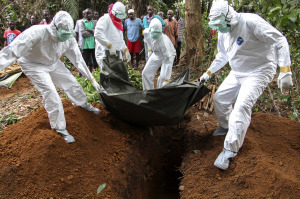By Leena Sen
The 2014 Ebola outbreak is ongoing and continues its devastating path throughout West African countries, centered in the countries of Guinea, Sierra Leone, and Liberia. Spread by the contact of bodily fluids (e.g. sweat, saliva, semen, breast milk, etc), Ebola is characterized by causing fatigue in its victims, inducing an influenza-like stage of fever, headache, sore throat, muscle pain, and so on. Patients also suffer from vomiting, abdominal pain and diarrhea, and then shortness of breath, swelling, chest pain, and confusion. A variety of other symptoms occur as well, including bleeding from mucous membranes, decreasing of blood clotting, and hematomas.
As of October 30th, 2014, the World Health Organization stated that the number of Ebola cases has risen to over 13,700– rising over 30 percent in a four-day period. The rise has been attributed to the underreporting of cases of the disease. However, the World Health Organization says Liberia, the country most affected by the epidemic, may be seeing a decline in Ebola.
According to Dr. Bruce Aylward, an assistant director-general of WHO, “The actual number of newly reported cases is beginning to decline in Liberia, and the government is really driving a multipronged investigation looking at multiple strands of evidence to try and understand is this real…based on the information received today, and again, most of you are somewhat aware of this, it appears that the trend is real in Liberia.”
Despite this hopeful outlook, Ebola still rages throughout parts of Sierra Leone, and Aylward also warned reporters that the decline in Liberia is at risk for not being sustained. Also, the figures of the Liberia’s Ebola cases are incomplete and the number of cases may be vastly underreported; but still the trend appears to be real. The number of burials have declined and there are more empty beds in treatment centers in Liberia. Aylward said there may be as much as a 25% week-on-week reduction in Liberia’s cases. In addition, the 2700 people shown in the WHO figures for Liberia’s total death toll dropped to 2400 within a couple days; a spokesman for the agency, Dan Epstein, said it was because many of these cases thought to be Ebola were actually not.
While many are reluctant to mark the decline as a trend, it is possible that the numbers have gone down. Nonetheless, the WHO’s Dr. Bruce Aylward states, “Am I hopeful? I’m terrified the information will be misinterpreted and people would start to think, oh great, this is under control,”… he then likens it to saying one’s pet tiger is under control.
Many continue to suffer from Ebola and its devastating impact on West African countries and other areas. At this point in time, experts still strongly advises the countries still experiencing increases in the cases to follow the example of countries with lowering numbers, and to continue staying out of contact with the fluids of patients, and other precautionary measures.











